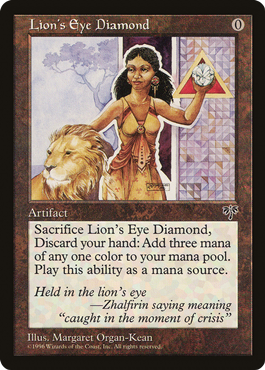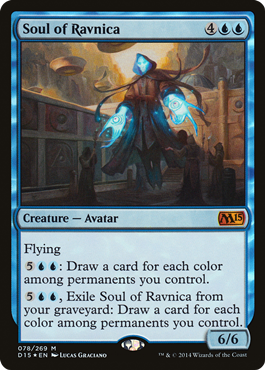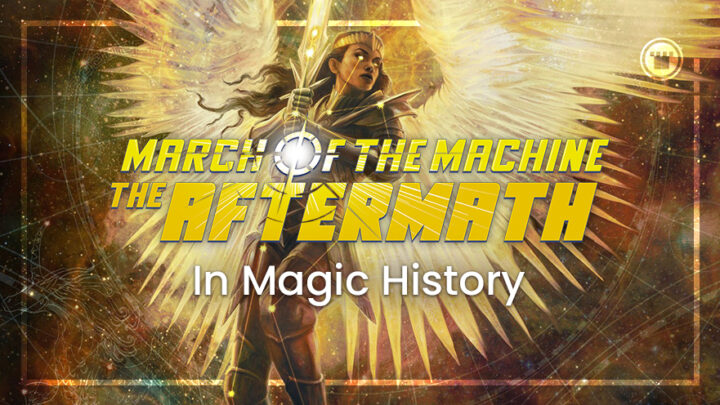March of the Machine: The Aftermath is a very odd Magic set for multiple reasons. Technically a supplemental set, it’s the first such set to be legal in Standard. Every other out-of-normal-rotation set has skipped over Standard entirely. Even odder, however, is the set’s size and packaging when compared to the rest of Magic history.
Aftermath has only 50 unique cards in total, making it the smallest expansion set in the game. For second place, we have to go all the way back to the first expansion set ever made: Arabian Nights. That weighed in at 78 unique cards, nearly double the size of Aftermath.
After some experimentation early on, “small” sets settled in at the mid-140s in size. The reason this lower limit ended up being adopted for a good chunk of Magic’s history has to do with the advent of Limited as a way to play.
Remember, Magic was a pioneer in trading card games. When it first debuted, Constructed was the only official way to play (and even that took a long time to settle into what we know today). Once Limited caught on, Magic settled on the mid-140s average as about as small as a set could be and still provide enough variety (when mixed with the larger set in its’ block, another idea that has fallen by the wayside) for an interesting Limited environment.
So how does a 50-card set possibly fit into modern Magic? Well…the short answer is, it kinda doesn’t. The idea almost feels like a throwback to an alternate history of the game where Limited never gained popularity and a slew of product design decisions that followed never came to be.
Ancient History

Asking what’s in a Magic booster nowadays will need some clarification on what kind of booster we’re talking, but for years before the advent of Set and Collector Boosters, there was only what is now known as Draft Boosters: 15 cards, 10 commons, three uncommons, one rare (or mythic ever since Shards of Alara) and one basic land. Also, an ad card/token, but those don’t count.
But this exact breakdown was not always the case, in terms of number and content. For example, just looking at Core sets, in Alpha, Beta, and Unlimited, there was no dedicated basic land slot. Instead, every other slot in the pack had a chance to be a basic land, which resulted in multiple basic lands per pack being the norm, and some packs having no actual rare.
Revised had no basic land slot, but any common or uncommon could be replaced by a basic land (rares were now blissfully safe from replacement). The land slot went away entirely in Fourth Edition, with basics only available in starter decks.
Meanwhile, outside of core sets, things were even wilder. Arabian Nights, the first expansion set, featured eight-card boosters, with six commons and two uncommons. That’s right, there was no rare slot, and there technically aren’t any rare cards in Arabian Nights. Instead, some uncommons were simply printed at half the rate as the other uncommons, making those cards de facto rares in practice, if not in name.
Antiquities continued this trend, with Legends finally bringing 15-card boosters and rares to expansion sets. The Dark went right back to eight-card boosters, as did Homelands and Fallen Empires — although Ice Age had 15-card boosters in the middle of that run. Alliances and Chronicles came in 12-card packs, with fewer common slots per pack.

Mirage started two key eras in Magic: it was the start of the SIlver Age of Magic design, where Limited was a major consideration in both card and product design, and it was the start of the three-set block structure, which would persist through Khans of Tarkir block.
This cemented the 15-card formula we still know today as the standard template for booster packs. And while the three-set block structure has since been left behind, Limited remains as popular as ever, and thus so does Draft pack structure.
But imagine for a moment that Limited hadn’t caught on, and the Silver Age of design focused elsewhere. I can totally see further experimentation with booster pack sizes, even perhaps leading to an earlier adoption of Set and Collector style alternate options for booster packs, which is well-tread territory by other games at this point.
Comparisons
Speaking of other games, a little detour. Magic may have pioneered the trading card game genre, but it’s not the only one in town. The Pokémon TCG has been around since 1999 and has generally smaller set sizes than Magic — including special expansion sets that feature sub-20 card counts, meant simply to inject some new tools into various formats.
Hearthstone, the first widely successful digital TCG, has a similar pattern, where it will periodically have very small sized (20-45 cards) expansions meant simply to give a format a kick in the arm, either bolstering existing archetypes or giving decks tools to fight their more prominent adversaries.
Both of these games differ greatly from Magic in the way they get developed. Hearthstone, being only digital, can afford to be a little nimbler and more reactive with their releases. Pokémon, meanwhile, has no official Limited format for tournament play, meaning their boosters don’t necessarily need to be designed with drafting in mind.
While these comparisons don’t match Magic 1-for-1, they do provide some possible reasoning for a set like Aftermath. But before we make a final verdict about the set’s place in Magic history, let’s take a trip to the more recent past.
Less Ancient History

Epilogue boosters from Aftermath may be the first five-card booster packs in Magic’s history, but Conflux got close with a run of special six-card boosters available from gravity-fed boxes at mass market retailers — and that style of big-box-store product stuck around up until Magic 2014.
Duels of the Planeswalkers, a videogame version of Magic predating Arena, also had codes that could be turned in at game stores for promotional, six-card packs. Standard Showdown, an event type for local game stores that existed from Kaladesh up until Magic 2020, featured special three-card boosters as a prize.
All of these products have something in common, however, that sets them apart from Epilogue Boosters: they are not meant to be the main booster product for that set. They are all ancillary — either introductory product meant to draw new and unentrenched players in or used as prizes specifically aimed at those more entrenched players.
Epilogue boosters are neither. It is about as far from an introductory product as you can get, being heavily steeped in lore and featuring zero common cards — and it certainly isn’t meant as a prize product. So what exactly is this set?
Experimentation and Problem Solving
Aftermath, ultimately, is an experiment on several different fronts. First, the boring part — business!
Aftermath is an attempt to see how a set like this will go over. A small set, not meant for drafting in paper, that allows for an injection of cards into all Constructed formats without needing to balance or test for Limited.
Even a small set like this is still going to be planned out well in advance, meaning you lose some of the reactionary speed that a game like Hearthstone has. So, a set like this can’t be planned to fix any glaring problems.
No, something like this is meant to shake things up, change the landscape of Standard (I’d guess that’s the format being aimed at, although I could see Pioneer getting a look in here as well) in a way you hope will keep it fresh and exciting. That’s doubly important given the recent announcement of a longer rotation time for the format.
However, and this is a big however, I believe all that is essentially an added bonus for this set being used to fix a different problem Magic was facing: the pacing of its story.
March of the Machine was the culmination of the main throughline of the last four sets (really 10, since the Praetors had started reappearing and laying groundwork for the multiverse invasion all the way back in Kaldheim), and the obvious climax of the story is the defeat of the Phyrexian army.
But the multiverse had to be affected by the invasion, and waiting to see the scope of those effects plane by plane would lock Magic into continually splitting its focus for a long time to come. Dedicating a full set to the…well, aftermath of the invasion might also feel like grinding the story to a halt, risking burnout with a too-long denouement.
Not to mention that Magic story tends to thrive off conflict, and dedicating a full set to rebuilding and mourning would make for a whole bunch of mechanical dissonance as you throw those recovering characters into a wizard fight (For the record, I would have been all for a full set dealing with the ramifications of the multiplanar invasion, but I can see the argument on the other side).
And that, ultimately, is what I think drove Wizards to the small Aftermath set as a solution. It’s a way to keep the story moving while largely dodging the need to design a full set and mechanics around a non-conflict driven set with a story that would need to splinter its focus across a dozen settings.
A small, out-of-cadence set allows for a more vignette feel, giving us small flashes of what each plane is going through while setting up new story beats (the Omenpaths and the desparking of numerous planeswalkers).
How well that works, for me, will depend on how much the story moving forward deals with all these plot threads, as well as things left hanging still (where are Jace and Vraska? What’s next for Tezzeret? And so on). If those answers, or at least hints at them, are forthcoming pretty quickly, then I’ll consider Aftermath a success at bridging the story.

Chris is the Associate Media Producer at Card Kingdom. He would like to apologize to his son for not holding onto more cards from when he first started playing, as that likely would have paid for college. He enjoys pretty much all formats of Magic, but usually ends up playing decks that make other people dislike playing those formats with him.


